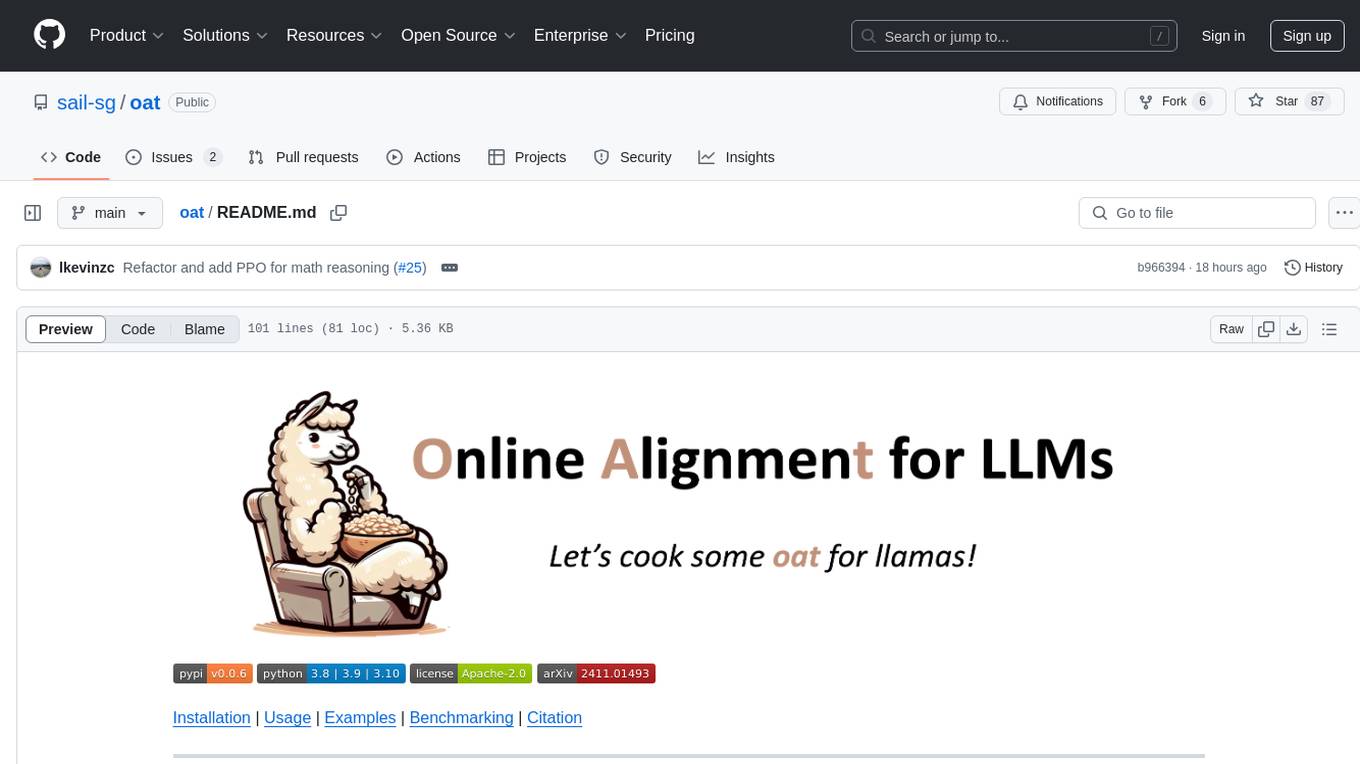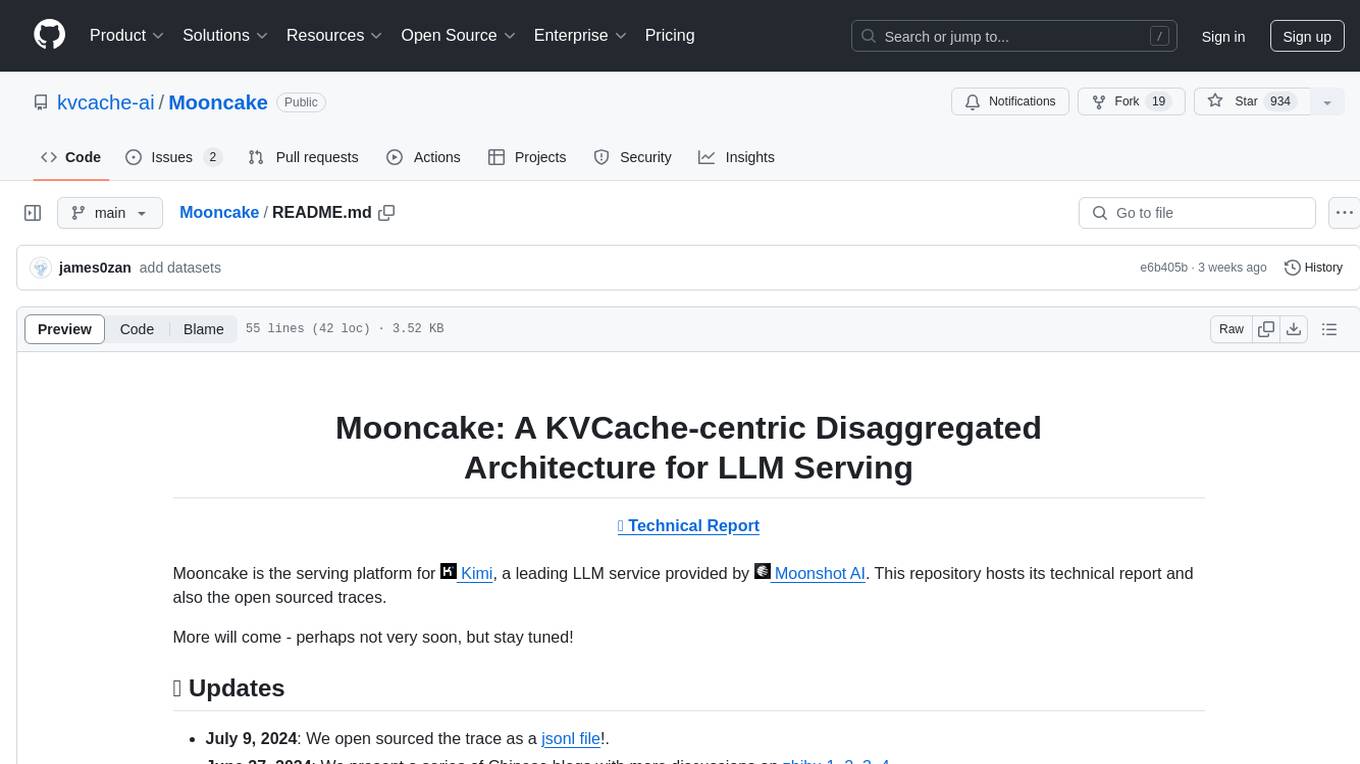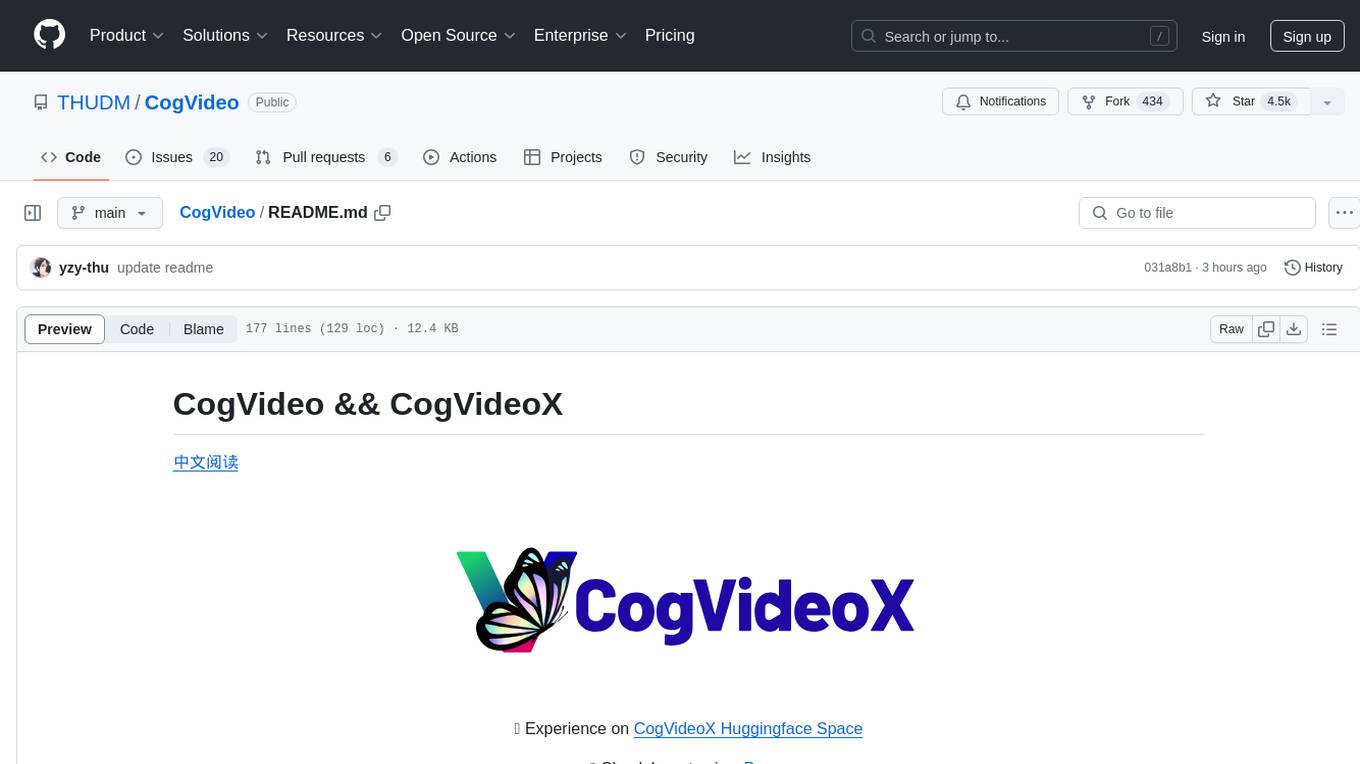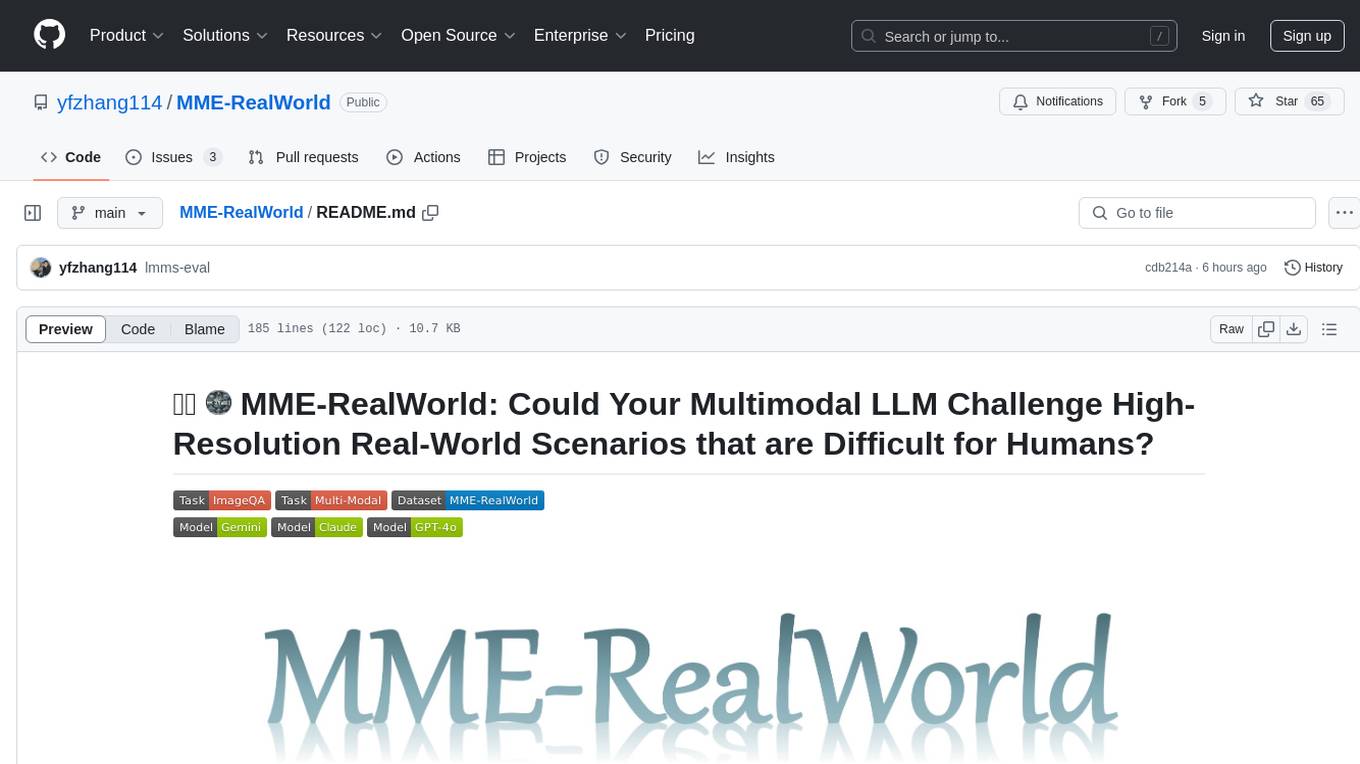
Genesis
A generative world for general-purpose robotics & embodied AI learning.
Stars: 27295

Genesis is a physics platform designed for general purpose Robotics/Embodied AI/Physical AI applications. It includes a universal physics engine, a lightweight, ultra-fast, pythonic, and user-friendly robotics simulation platform, a powerful and fast photo-realistic rendering system, and a generative data engine that transforms user-prompted natural language description into various modalities of data. It aims to lower the barrier to using physics simulations, unify state-of-the-art physics solvers, and minimize human effort in collecting and generating data for robotics and other domains.
README:
- [2025-08-05] Released v0.3.0 🎊 🎉
- [2025-07-02] The development of Genesis is now officially supported by Genesis AI.
- [2025-01-09] We released a detailed performance benchmarking and comparison report on Genesis, together with all the test scripts.
- [2025-01-08] Released v0.2.1 🎊 🎉
- [2025-01-08] Created Discord and Wechat group.
- [2024-12-25] Added a docker including support for the ray-tracing renderer
- [2024-12-24] Added guidelines for contributing to Genesis
- What is Genesis?
- Key Features
- Quick Installation
- Docker
- Documentation
- Contributing to Genesis
- Support
- License and Acknowledgments
- Associated Papers
- Citation
Genesis is a physics platform designed for general-purpose Robotics/Embodied AI/Physical AI applications. It is simultaneously multiple things:
- A universal physics engine re-built from the ground up, capable of simulating a wide range of materials and physical phenomena.
- A lightweight, ultra-fast, pythonic, and user-friendly robotics simulation platform.
- A powerful and fast photo-realistic rendering system.
- A generative data engine that transforms user-prompted natural language description into various modalities of data.
Powered by a universal physics engine re-designed and re-built from the ground up, Genesis integrates various physics solvers and their coupling into a unified framework. This core physics engine is further enhanced by a generative agent framework that operates at an upper level, aiming towards fully automated data generation for robotics and beyond.
Note: Currently, we are open-sourcing the underlying physics engine and the simulation platform. Our generative framework is a modular system that incorporates many different generative modules, each handling a certain range of data modalities, routed by a high level agent. Some of the modules integrated existing papers and some are still under submission. Access to our generative feature will be gradually rolled out in the near future. If you are interested, feel free to explore more in the paper list below.
Genesis aims to:
- Lower the barrier to using physics simulations, making robotics research accessible to everyone. See our mission statement.
- Unify diverse physics solvers into a single framework to recreate the physical world with the highest fidelity.
- Automate data generation, reducing human effort and letting the data flywheel spin on its own.
Project Page: https://genesis-embodied-ai.github.io/
- Speed: Over 43 million FPS when simulating a Franka robotic arm with a single RTX 4090 (430,000 times faster than real-time).
- Cross-platform: Runs on Linux, macOS, Windows, and supports multiple compute backends (CPU, Nvidia/AMD GPUs, Apple Metal).
- Integration of diverse physics solvers: Rigid body, MPM, SPH, FEM, PBD, Stable Fluid.
- Wide range of material models: Simulation and coupling of rigid bodies, liquids, gases, deformable objects, thin-shell objects, and granular materials.
-
Compatibility with various robots: Robotic arms, legged robots, drones, soft robots, and support for loading
MJCF (.xml),URDF,.obj,.glb,.ply,.stl, and more. - Photo-realistic rendering: Native ray-tracing-based rendering.
- Differentiability: Genesis is designed to be fully differentiable. Currently, our MPM solver and Tool Solver support differentiability, with other solvers planned for future versions (starting with rigid & articulated body solver).
- User-friendliness: Designed for simplicity, with intuitive installation and APIs.
Install PyTorch first following the official instructions.
Then, install Genesis via PyPI:
pip install genesis-world # Requires Python>=3.10,<3.14;For the latest version to date, make sure that pip is up-to-date via pip install --upgrade pip, then run command:
pip install git+https://github.com/Genesis-Embodied-AI/Genesis.gitNote that the package must still be updated manually to sync with main branch.
Users seeking to contribute are encouraged to install Genesis in editable mode. First, make sure that genesis-world has been uninstalled, then clone the repository and install locally:
git clone https://github.com/Genesis-Embodied-AI/Genesis.git
cd Genesis
pip install -e ".[dev]"It is recommended to systematically execute pip install -e ".[dev]" after moving HEAD to make sure that all dependencies and entrypoints are up-to-date.
If you want to use Genesis from Docker, you can first build the Docker image as:
docker build -t genesis -f docker/Dockerfile dockerThen you can run the examples inside the docker image (mounted to /workspace/examples):
xhost +local:root # Allow the container to access the display
docker run --gpus all --rm -it \
-e DISPLAY=$DISPLAY \
-e LOCAL_USER_ID="$(id -u)" \
-v /dev/dri:/dev/dri \
-v /tmp/.X11-unix/:/tmp/.X11-unix \
-v $(pwd):/workspace \
--name genesis genesis:latestAMD users can use Genesis using the docker/Dockerfile.amdgpu file, which is built by running:
docker build -t genesis-amd -f docker/Dockerfile.amdgpu docker
and can then be used by running:
docker run -it --network=host \
--device=/dev/kfd \
--device=/dev/dri \
--group-add=video \
--ipc=host \
--cap-add=SYS_PTRACE \
--security-opt seccomp=unconfined \
--shm-size 8G \
-v $PWD:/workspace \
-e DISPLAY=$DISPLAY \
genesis-amd
The examples will be accessible from /workspace/examples. Note: AMD users should use the vulkan backend. This means you will need to call gs.init(vulkan) to initialise Genesis.
Comprehensive documentation is available in English, Chinese, and Japanese. This includes detailed installation steps, tutorials, and API references.
The Genesis project is an open and collaborative effort. We welcome all forms of contributions from the community, including:
- Pull requests for new features or bug fixes.
- Bug reports through GitHub Issues.
- Suggestions to improve Genesis's usability.
Refer to our contribution guide for more details.
- Report bugs or request features via GitHub Issues.
- Join discussions or ask questions on GitHub Discussions.
The Genesis source code is licensed under Apache 2.0.
Genesis's development has been made possible thanks to these open-source projects:
- Taichi: High-performance cross-platform compute backend. Kudos to the Taichi team for their technical support!
- FluidLab: Reference MPM solver implementation.
- SPH_Taichi: Reference SPH solver implementation.
- Ten Minute Physics and PBF3D: Reference PBD solver implementations.
- MuJoCo: Reference for rigid body dynamics.
- libccd: Reference for collision detection.
- PyRender: Rasterization-based renderer.
- LuisaCompute and LuisaRender: Ray-tracing DSL.
- Madrona and Madrona-mjx: Batch renderer backend
Genesis is a large scale effort that integrates state-of-the-art technologies of various existing and on-going research work into a single system. Here we include a non-exhaustive list of all the papers that contributed to the Genesis project in one way or another:
- Xian, Zhou, et al. "Fluidlab: A differentiable environment for benchmarking complex fluid manipulation." arXiv preprint arXiv:2303.02346 (2023).
- Xu, Zhenjia, et al. "Roboninja: Learning an adaptive cutting policy for multi-material objects." arXiv preprint arXiv:2302.11553 (2023).
- Wang, Yufei, et al. "Robogen: Towards unleashing infinite data for automated robot learning via generative simulation." arXiv preprint arXiv:2311.01455 (2023).
- Wang, Tsun-Hsuan, et al. "Softzoo: A soft robot co-design benchmark for locomotion in diverse environments." arXiv preprint arXiv:2303.09555 (2023).
- Wang, Tsun-Hsuan Johnson, et al. "Diffusebot: Breeding soft robots with physics-augmented generative diffusion models." Advances in Neural Information Processing Systems 36 (2023): 44398-44423.
- Katara, Pushkal, Zhou Xian, and Katerina Fragkiadaki. "Gen2sim: Scaling up robot learning in simulation with generative models." 2024 IEEE International Conference on Robotics and Automation (ICRA). IEEE, 2024.
- Si, Zilin, et al. "DiffTactile: A Physics-based Differentiable Tactile Simulator for Contact-rich Robotic Manipulation." arXiv preprint arXiv:2403.08716 (2024).
- Wang, Yian, et al. "Thin-Shell Object Manipulations With Differentiable Physics Simulations." arXiv preprint arXiv:2404.00451 (2024).
- Lin, Chunru, et al. "UBSoft: A Simulation Platform for Robotic Skill Learning in Unbounded Soft Environments." arXiv preprint arXiv:2411.12711 (2024).
- Zhou, Wenyang, et al. "EMDM: Efficient motion diffusion model for fast and high-quality motion generation." European Conference on Computer Vision. Springer, Cham, 2025.
- Qiao, Yi-Ling, Junbang Liang, Vladlen Koltun, and Ming C. Lin. "Scalable differentiable physics for learning and control." International Conference on Machine Learning. PMLR, 2020.
- Qiao, Yi-Ling, Junbang Liang, Vladlen Koltun, and Ming C. Lin. "Efficient differentiable simulation of articulated bodies." In International Conference on Machine Learning, PMLR, 2021.
- Qiao, Yi-Ling, Junbang Liang, Vladlen Koltun, and Ming Lin. "Differentiable simulation of soft multi-body systems." Advances in Neural Information Processing Systems 34 (2021).
- Wan, Weilin, et al. "Tlcontrol: Trajectory and language control for human motion synthesis." arXiv preprint arXiv:2311.17135 (2023).
- Wang, Yian, et al. "Architect: Generating Vivid and Interactive 3D Scenes with Hierarchical 2D Inpainting." arXiv preprint arXiv:2411.09823 (2024).
- Zheng, Shaokun, et al. "LuisaRender: A high-performance rendering framework with layered and unified interfaces on stream architectures." ACM Transactions on Graphics (TOG) 41.6 (2022): 1-19.
- Fan, Yingruo, et al. "Faceformer: Speech-driven 3d facial animation with transformers." Proceedings of the IEEE/CVF Conference on Computer Vision and Pattern Recognition. 2022.
- Wu, Sichun, Kazi Injamamul Haque, and Zerrin Yumak. "ProbTalk3D: Non-Deterministic Emotion Controllable Speech-Driven 3D Facial Animation Synthesis Using VQ-VAE." Proceedings of the 17th ACM SIGGRAPH Conference on Motion, Interaction, and Games. 2024.
- Dou, Zhiyang, et al. "C· ase: Learning conditional adversarial skill embeddings for physics-based characters." SIGGRAPH Asia 2023 Conference Papers. 2023.
... and many more on-going work.
If you use Genesis in your research, please consider citing:
@misc{Genesis,
author = {Genesis Authors},
title = {Genesis: A Generative and Universal Physics Engine for Robotics and Beyond},
month = {December},
year = {2024},
url = {https://github.com/Genesis-Embodied-AI/Genesis}
}For Tasks:
Click tags to check more tools for each tasksFor Jobs:
Alternative AI tools for Genesis
Similar Open Source Tools

Genesis
Genesis is a physics platform designed for general purpose Robotics/Embodied AI/Physical AI applications. It includes a universal physics engine, a lightweight, ultra-fast, pythonic, and user-friendly robotics simulation platform, a powerful and fast photo-realistic rendering system, and a generative data engine that transforms user-prompted natural language description into various modalities of data. It aims to lower the barrier to using physics simulations, unify state-of-the-art physics solvers, and minimize human effort in collecting and generating data for robotics and other domains.

oat
Oat is a simple and efficient framework for running online LLM alignment algorithms. It implements a distributed Actor-Learner-Oracle architecture, with components optimized using state-of-the-art tools. Oat simplifies the experimental pipeline of LLM alignment by serving an Oracle online for preference data labeling and model evaluation. It provides a variety of oracles for simulating feedback and supports verifiable rewards. Oat's modular structure allows for easy inheritance and modification of classes, enabling rapid prototyping and experimentation with new algorithms. The framework implements cutting-edge online algorithms like PPO for math reasoning and various online exploration algorithms.

FinRobot
FinRobot is an open-source AI agent platform designed for financial applications using large language models. It transcends the scope of FinGPT, offering a comprehensive solution that integrates a diverse array of AI technologies. The platform's versatility and adaptability cater to the multifaceted needs of the financial industry. FinRobot's ecosystem is organized into four layers, including Financial AI Agents Layer, Financial LLMs Algorithms Layer, LLMOps and DataOps Layers, and Multi-source LLM Foundation Models Layer. The platform's agent workflow involves Perception, Brain, and Action modules to capture, process, and execute financial data and insights. The Smart Scheduler optimizes model diversity and selection for tasks, managed by components like Director Agent, Agent Registration, Agent Adaptor, and Task Manager. The tool provides a structured file organization with subfolders for agents, data sources, and functional modules, along with installation instructions and hands-on tutorials.

Mooncake
Mooncake is a serving platform for Kimi, a leading LLM service provided by Moonshot AI. It features a KVCache-centric disaggregated architecture that separates prefill and decoding clusters, leveraging underutilized CPU, DRAM, and SSD resources of the GPU cluster. Mooncake's scheduler balances throughput and latency-related SLOs, with a prediction-based early rejection policy for highly overloaded scenarios. It excels in long-context scenarios, achieving up to a 525% increase in throughput while handling 75% more requests under real workloads.

dash-infer
DashInfer is a C++ runtime tool designed to deliver production-level implementations highly optimized for various hardware architectures, including x86 and ARMv9. It supports Continuous Batching and NUMA-Aware capabilities for CPU, and can fully utilize modern server-grade CPUs to host large language models (LLMs) up to 14B in size. With lightweight architecture, high precision, support for mainstream open-source LLMs, post-training quantization, optimized computation kernels, NUMA-aware design, and multi-language API interfaces, DashInfer provides a versatile solution for efficient inference tasks. It supports x86 CPUs with AVX2 instruction set and ARMv9 CPUs with SVE instruction set, along with various data types like FP32, BF16, and InstantQuant. DashInfer also offers single-NUMA and multi-NUMA architectures for model inference, with detailed performance tests and inference accuracy evaluations available. The tool is supported on mainstream Linux server operating systems and provides documentation and examples for easy integration and usage.

raga-llm-hub
Raga LLM Hub is a comprehensive evaluation toolkit for Language and Learning Models (LLMs) with over 100 meticulously designed metrics. It allows developers and organizations to evaluate and compare LLMs effectively, establishing guardrails for LLMs and Retrieval Augmented Generation (RAG) applications. The platform assesses aspects like Relevance & Understanding, Content Quality, Hallucination, Safety & Bias, Context Relevance, Guardrails, and Vulnerability scanning, along with Metric-Based Tests for quantitative analysis. It helps teams identify and fix issues throughout the LLM lifecycle, revolutionizing reliability and trustworthiness.

LLM-Zero-to-Hundred
LLM-Zero-to-Hundred is a repository showcasing various applications of LLM chatbots and providing insights into training and fine-tuning Language Models. It includes projects like WebGPT, RAG-GPT, WebRAGQuery, LLM Full Finetuning, RAG-Master LLamaindex vs Langchain, open-source-RAG-GEMMA, and HUMAIN: Advanced Multimodal, Multitask Chatbot. The projects cover features like ChatGPT-like interaction, RAG capabilities, image generation and understanding, DuckDuckGo integration, summarization, text and voice interaction, and memory access. Tutorials include LLM Function Calling and Visualizing Text Vectorization. The projects have a general structure with folders for README, HELPER, .env, configs, data, src, images, and utils.

MathCoder
MathCoder is a repository focused on enhancing mathematical reasoning by fine-tuning open-source language models to use code for modeling and deriving math equations. It introduces MathCodeInstruct dataset with solutions interleaving natural language, code, and execution results. The repository provides MathCoder models capable of generating code-based solutions for challenging math problems, achieving state-of-the-art scores on MATH and GSM8K datasets. It offers tools for model deployment, inference, and evaluation, along with a citation for referencing the work.

k2
K2 (GeoLLaMA) is a large language model for geoscience, trained on geoscience literature and fine-tuned with knowledge-intensive instruction data. It outperforms baseline models on objective and subjective tasks. The repository provides K2 weights, core data of GeoSignal, GeoBench benchmark, and code for further pretraining and instruction tuning. The model is available on Hugging Face for use. The project aims to create larger and more powerful geoscience language models in the future.

CogVideo
CogVideo is an open-source repository that provides pretrained text-to-video models for generating videos based on input text. It includes models like CogVideoX-2B and CogVideo, offering powerful video generation capabilities. The repository offers tools for inference, fine-tuning, and model conversion, along with demos showcasing the model's capabilities through CLI, web UI, and online experiences. CogVideo aims to facilitate the creation of high-quality videos from textual descriptions, catering to a wide range of applications.

slideflow
Slideflow is a deep learning library for digital pathology, offering a user-friendly interface for model development. It is designed for medical researchers and AI enthusiasts, providing an accessible platform for developing state-of-the-art pathology models. Slideflow offers customizable training pipelines, robust slide processing and stain normalization toolkit, support for weakly-supervised or strongly-supervised labels, built-in foundation models, multiple-instance learning, self-supervised learning, generative adversarial networks, explainability tools, layer activation analysis tools, uncertainty quantification, interactive user interface for model deployment, and more. It supports both PyTorch and Tensorflow, with optional support for Libvips for slide reading. Slideflow can be installed via pip, Docker container, or from source, and includes non-commercial add-ons for additional tools and pretrained models. It allows users to create projects, extract tiles from slides, train models, and provides evaluation tools like heatmaps and mosaic maps.

workflows-py
LlamaIndex Workflows is a framework for orchestrating and chaining together complex systems of steps and events. It shines in orchestrating complex, multi-step processes involving AI models, APIs, and decision-making. The async-first, event-driven architecture allows building workflows that can route between different capabilities, implement parallel processing patterns, loop over complex sequences, and maintain state across multiple steps. Key features include async-first design, event-driven structure, state management, and observability through tools like Arize Phoenix and OpenTelemetry.

MME-RealWorld
MME-RealWorld is a benchmark designed to address real-world applications with practical relevance, featuring 13,366 high-resolution images and 29,429 annotations across 43 tasks. It aims to provide substantial recognition challenges and overcome common barriers in existing Multimodal Large Language Model benchmarks, such as small data scale, restricted data quality, and insufficient task difficulty. The dataset offers advantages in data scale, data quality, task difficulty, and real-world utility compared to existing benchmarks. It also includes a Chinese version with additional images and QA pairs focused on Chinese scenarios.

Reflection_Tuning
Reflection-Tuning is a project focused on improving the quality of instruction-tuning data through a reflection-based method. It introduces Selective Reflection-Tuning, where the student model can decide whether to accept the improvements made by the teacher model. The project aims to generate high-quality instruction-response pairs by defining specific criteria for the oracle model to follow and respond to. It also evaluates the efficacy and relevance of instruction-response pairs using the r-IFD metric. The project provides code for reflection and selection processes, along with data and model weights for both V1 and V2 methods.

aistore
AIStore is a lightweight object storage system designed for AI applications. It is highly scalable, reliable, and easy to use. AIStore can be deployed on any commodity hardware, and it can be used to store and manage large datasets for deep learning and other AI applications.

aigne-framework
AIGNE Framework is a functional AI application development framework designed to simplify and accelerate the process of building modern applications. It combines functional programming features, powerful artificial intelligence capabilities, and modular design principles to help developers easily create scalable solutions. With key features like modular design, TypeScript support, multiple AI model support, flexible workflow patterns, MCP protocol integration, code execution capabilities, and Blocklet ecosystem integration, AIGNE Framework offers a comprehensive solution for developers. The framework provides various workflow patterns such as Workflow Router, Workflow Sequential, Workflow Concurrency, Workflow Handoff, Workflow Reflection, Workflow Orchestration, Workflow Code Execution, and Workflow Group Chat to address different application scenarios efficiently. It also includes built-in MCP support for running MCP servers and integrating with external MCP servers, along with packages for core functionality, agent library, CLI, and various models like OpenAI, Gemini, Claude, and Nova.
For similar tasks

Genesis
Genesis is a physics platform designed for general purpose Robotics/Embodied AI/Physical AI applications. It includes a universal physics engine, a lightweight, ultra-fast, pythonic, and user-friendly robotics simulation platform, a powerful and fast photo-realistic rendering system, and a generative data engine that transforms user-prompted natural language description into various modalities of data. It aims to lower the barrier to using physics simulations, unify state-of-the-art physics solvers, and minimize human effort in collecting and generating data for robotics and other domains.

OmniGibson
OmniGibson is a platform for accelerating Embodied AI research built upon NVIDIA's Omniverse platform. It features photorealistic visuals, physical realism, fluid and soft body support, large-scale high-quality scenes and objects, dynamic kinematic and semantic object states, mobile manipulator robots with modular controllers, and an OpenAI Gym interface. The platform provides a comprehensive environment for researchers to conduct experiments and simulations in the field of Embodied AI.
For similar jobs

weave
Weave is a toolkit for developing Generative AI applications, built by Weights & Biases. With Weave, you can log and debug language model inputs, outputs, and traces; build rigorous, apples-to-apples evaluations for language model use cases; and organize all the information generated across the LLM workflow, from experimentation to evaluations to production. Weave aims to bring rigor, best-practices, and composability to the inherently experimental process of developing Generative AI software, without introducing cognitive overhead.

LLMStack
LLMStack is a no-code platform for building generative AI agents, workflows, and chatbots. It allows users to connect their own data, internal tools, and GPT-powered models without any coding experience. LLMStack can be deployed to the cloud or on-premise and can be accessed via HTTP API or triggered from Slack or Discord.

VisionCraft
The VisionCraft API is a free API for using over 100 different AI models. From images to sound.

kaito
Kaito is an operator that automates the AI/ML inference model deployment in a Kubernetes cluster. It manages large model files using container images, avoids tuning deployment parameters to fit GPU hardware by providing preset configurations, auto-provisions GPU nodes based on model requirements, and hosts large model images in the public Microsoft Container Registry (MCR) if the license allows. Using Kaito, the workflow of onboarding large AI inference models in Kubernetes is largely simplified.

PyRIT
PyRIT is an open access automation framework designed to empower security professionals and ML engineers to red team foundation models and their applications. It automates AI Red Teaming tasks to allow operators to focus on more complicated and time-consuming tasks and can also identify security harms such as misuse (e.g., malware generation, jailbreaking), and privacy harms (e.g., identity theft). The goal is to allow researchers to have a baseline of how well their model and entire inference pipeline is doing against different harm categories and to be able to compare that baseline to future iterations of their model. This allows them to have empirical data on how well their model is doing today, and detect any degradation of performance based on future improvements.

tabby
Tabby is a self-hosted AI coding assistant, offering an open-source and on-premises alternative to GitHub Copilot. It boasts several key features: * Self-contained, with no need for a DBMS or cloud service. * OpenAPI interface, easy to integrate with existing infrastructure (e.g Cloud IDE). * Supports consumer-grade GPUs.

spear
SPEAR (Simulator for Photorealistic Embodied AI Research) is a powerful tool for training embodied agents. It features 300 unique virtual indoor environments with 2,566 unique rooms and 17,234 unique objects that can be manipulated individually. Each environment is designed by a professional artist and features detailed geometry, photorealistic materials, and a unique floor plan and object layout. SPEAR is implemented as Unreal Engine assets and provides an OpenAI Gym interface for interacting with the environments via Python.

Magick
Magick is a groundbreaking visual AIDE (Artificial Intelligence Development Environment) for no-code data pipelines and multimodal agents. Magick can connect to other services and comes with nodes and templates well-suited for intelligent agents, chatbots, complex reasoning systems and realistic characters.











